Square Foot Gardening Layout Plans Free

It's been a buzzword in the gardening world for decades: the square foot garden, a revolution in small space gardening everywhere.
It doesn't take much imagination to figure out what this basic concept entails.
It involves carefully measuring gardening plots. Careful planning can have a huge impact on how much food you grow, and how much waste you can avoid.
But for traditional gardeners and acolytes of other styles (like myself), we may need a bit more of a formal intro!
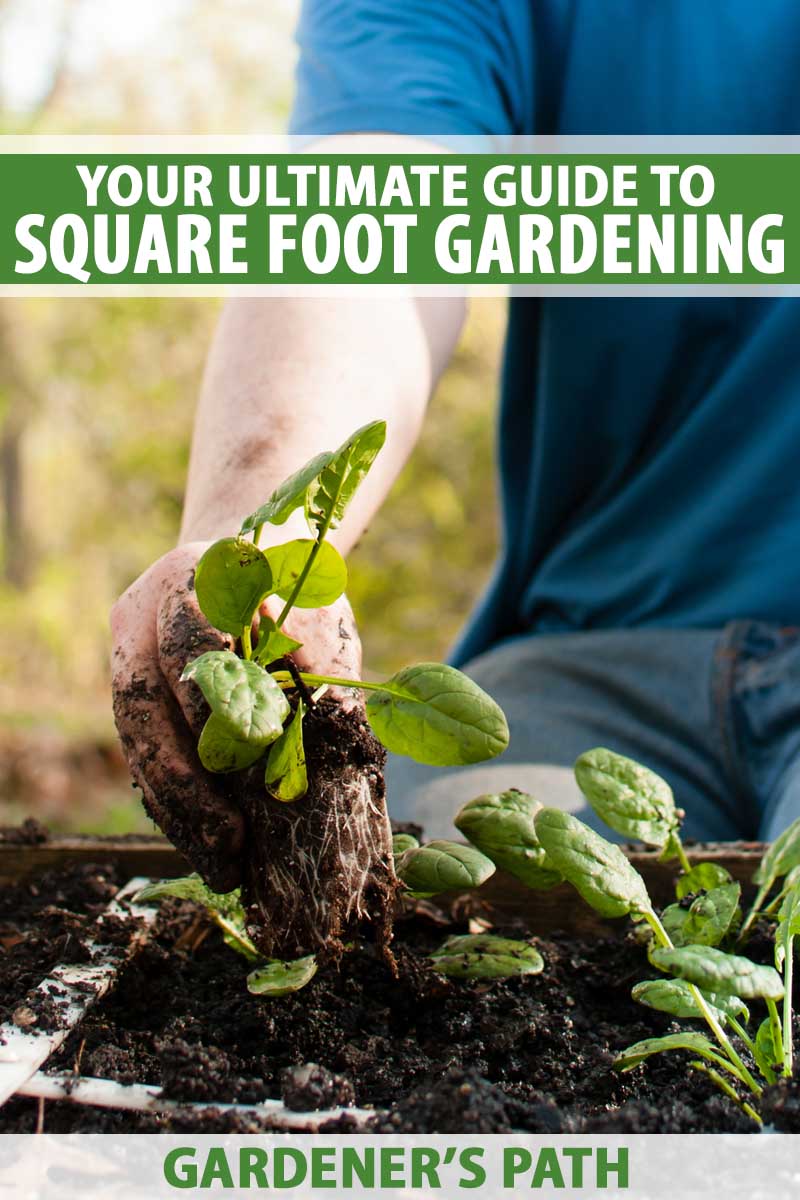
We link to vendors to help you find relevant products. If you buy from one of our links, we may earn a commission .
What is square foot gardening, and where did it come from? What's so great about it? Why do people still use the method in gardens today, and why is it so popular?
Sure, it involves the clever use of square foot measurements to get the most out of your growing space. But nowadays, with a burgeoning local food movement and a passion for home growing, knowing all the ins and outs of this ideology means a whole lot more.

Without further ado, let's dig in and take a look!
What You'll Learn
- Square Foot's Roots
- What is Square Foot Gardening?
- The Basic Setup
- Growing on the Grid
- What About Perennial Vegetables?
- Fancy Footwork
- Companion Planting Tips
- Square Foot Layout Tips
- Starting Out
- Setting the Pace
So, what is square foot gardening anyway, and where did it come from?
In essence, it is an approach to growing food that incorporates companion planting, intensive spacing, and getting the most food possible out of a small space.
It all started in 1981 as a concept developed and coined by civil engineer Mel Bartholomew, author of Square Foot Gardening.

Square Foot Gardening, available on Amazon
In his experiences as an urban planner, Bartholomew brought attention to less efficient and productive methods of traditional single-row gardening. A hobby gardener himself, he combined his city design and planning skills with his green thumb to come up with the ever-practical square foot garden – and thus, his book was born.
The book quickly caught fire as an exciting new way to grow more food in small spaces, not only for the average gardener but to also improve health, ergonomics, space use, and even food security among populations in need around the world.
Its first edition is known as one of America's bestselling gardening books of all time, with over a million copies sold.
Decades later, the book continued to be top-tier among gardening guides – so continuously purchased, used, and enjoyed, that a long-awaited update of the book was released in 2006 as The All New Square Foot Gardening, followed by a second edition in 2013. You'll find it on Amazon.

All New Square Foot Gardening II: The Revolutionary Way to Grow More in Less Space
Even now, Bartholomew sporadically updates his concept with new techniques and information to be more informed with modern gardening methods and fads that befit today's gardeners.
A book that is so persistent as a horticultural classic must contain some kernel of truth, right? That's exactly the point: this method of gardening is timeless, a classic that's still relevant at a time when food issues are at the forefront of household concerns.
This led him to release yet another wave of square foot gardening books. Bartholomew's second edition of All New Square Foot Gardening was published in 2013. It explores many of today's hot gardening trends including vertical gardening, pest control, and gardening with your kids.
A book that is so persistent as a horticultural classic must contain some kernel of truth, right? That's exactly the point: this method of gardening is timeless, a classic that's still relevant at a time when food issues are at the forefront of household concerns.
Even though it was conceived decades ago, the essence of its greatness still shows in space-saving, DIY food production techniques for the home that aren't at all difficult to adopt.
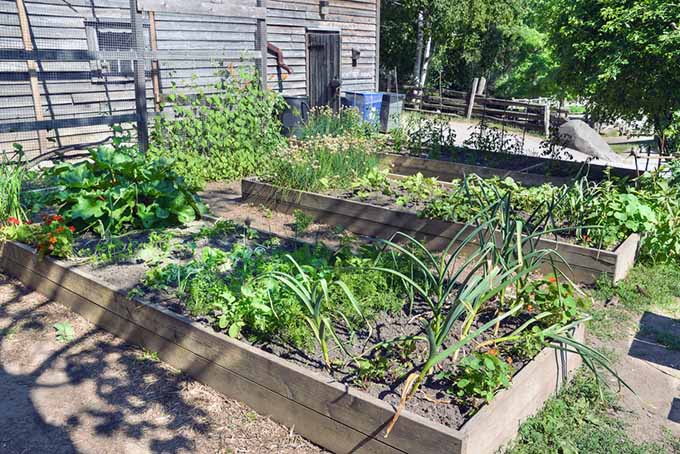
Can you learn them yourself? Of course! Let's take a look at how you can make these methods yours.
First of all – what exactly are the benefits of square foot gardening? Why is it a worthwhile approach to gardening in the first place?
For the backyard gardener, or even the newbie to urban homesteading, this perennial method is your perfect food-growing option for more than just a few reasons:
- Grow as much food within a small space as you would with some traditional row-planted gardens
- Compact 4-by-4 foot raised bed garden makes for easy access
- No need for a big yard – grow food on patio, balcony, or smaller plot
- No weeding at all (with the right setup using weed-free soil mix)
- Less work and strain on the body
- No negative effects or damage to the yard
- Incredibly easy – ideal for new gardeners
- Save money with minimal management by sourcing your own food
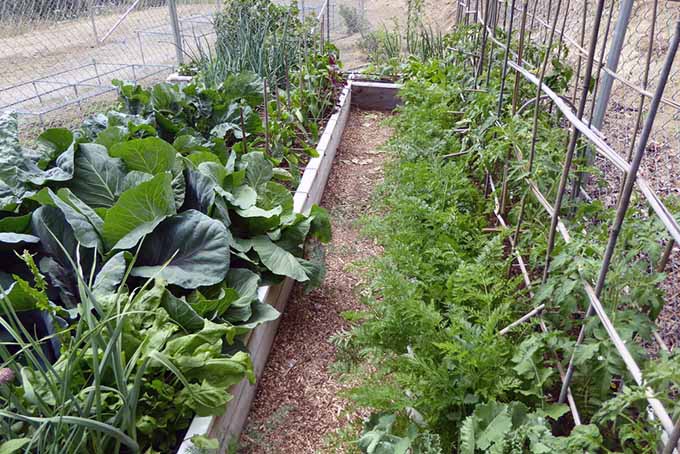
That's right: with this clever gardening approach, you are essentially sourcing your own food from tiny spaces, saving yourself money and hardly having to put any work into it!
And no – you don't need that huge backyard or tiller you once assumed you might to get started.
Due to the tight, compact, yet healthy spacing implemented using this method, you can competitively produce as much food as you might in a larger space that was planted using less-space efficient row crop methods.
Due to the tight, compact, yet healthy spacing implemented using this method, you can competitively produce as much food as you might in a larger space that was planted using less-space efficient row crop methods.
Sure, traditional row-cropping guarantees healthy plants with ample spacing between rows, but square foot gardening begs the question: couldn't more plants be used in those spaces as well?
Plus, in a 4×4 foot raised bed structure (the method's standard raised bed dimensions), you don't have to do anywhere near the amount of work required for the in-ground planting of a larger plot.
With the purchase or construction of such a bed (whether wood, plastic, fabric, or even DIY from makeshift cinder blocks) and the addition of a bottom lining, you can keep your bed completely weed free – thus eliminating out a good chunk of the gardening work entirely.
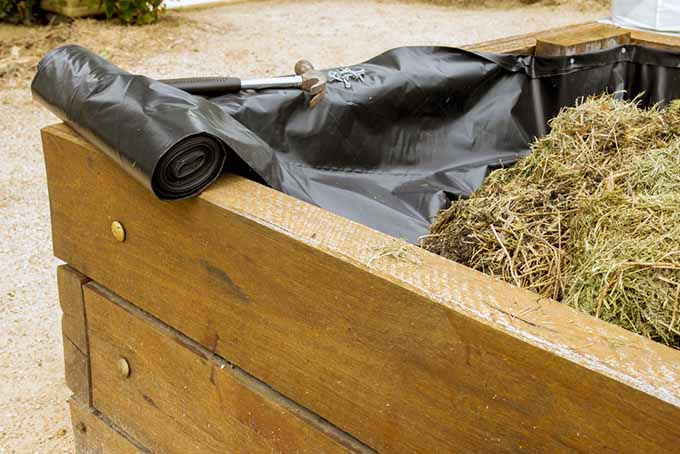
This is especially true if you add a seed-free soil mix rather than planting in soil from your own yard, an important aspect of Bartholomew's method.
The method's standard 4-by-4-foot total raised bed growing space is also the perfect size for reaching across to get to just about any spot in the bed, whether for weeding, planting, amending – you name it. This is quite the ergonomic option!
Plus, the techniques for setting up and planting are incredibly easy to learn, and can even provide the perfect medium for a beginner who is just starting out on their first adventures in edible gardening.
Of course, anything truly great tends to draw at least a little heat! Some critics of the method state that, in spite of its space- and work-saving techniques, startup can be expensive – the purchase or construction of a raised bed may be costly, as can getting your hands on completely weed-free, nutrient-rich potting soil or compost.
My comeback to that? Sure, you might ring up startup costs in the $100 range (though the initial cost tends to be much lower if you're a smart bargain-hunter or handyperson), but think about the ultimate impact on your food budget (and self-confidence that will be gained in growing your own food) over time!
That's right: over time, you'll save money on your food budget by growing your own food (while feeling good and healthy about it!)
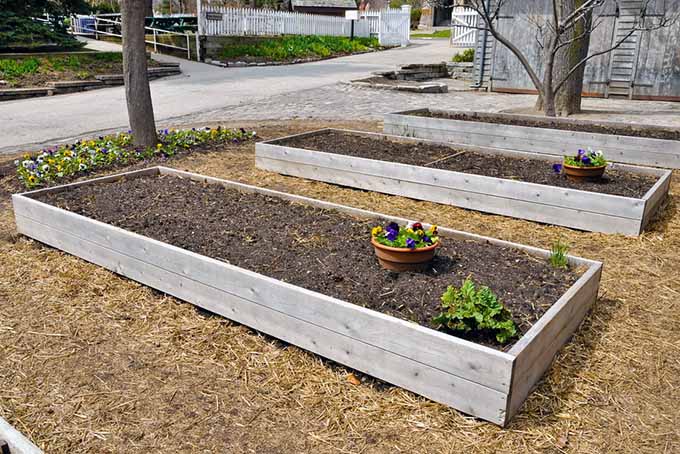
Sourcing your own food straight from your backyard with this method is also an excellent way to feel proactive about changing your part of the food system for the better.
By growing an edible garden organically and by using this method in your own backyard, you're getting produce straight from your own soil at much smaller environmental and health costs, in comparison to the average grocery store produce.
The Basic Setup
Square foot gardening has a time-honored, well-tested place in the gardening world, with many noticeable benefits to gardening and lifestyle.
But what are the special techniques that bring about such awesome results?
At their foundation, they are very basic and ridiculously simple to learn:
1. Get Your Grow Space
First, build (or buy) a 4-by-4 foot raised bed box (lined with weed barrier landscaping fabric if you want less weeds and you're building on top of other soil).
2. Put In Your Preferred Soil
Fill it with fertile potting soil (part peat moss, compost, and vermiculite, or another mix of your choice – preferably weed free).
3. Lay Out Your Grid
Overlay a square foot grid atop your box for plant spacing, then plant your seeds.
4. Get Growing!
Water, grow, and presto!
All of these steps seem pretty simple, right? Nothing new to most of you green thumbs out there.
But you might have noticed the obvious thing that makes this method different from other techniques: the square foot grid.
According to Bartholomew's canon, this grid is typically an easy-to-make, homemade measuring tool crafted from long, thin slats of wood (particularly lath) that are then cross-hatched and fashioned into square foot-sized squares.
This grid is then fastened atop one's 4-by-4 foot wooden beds, and used to measure and designate specific 1-by-1-foot planting areas for various herbs, veggies, and more.
If you're not the handyman (or handywoman) type, these grids can be found for purchase on Amazon, primarily made of fiberglass material.
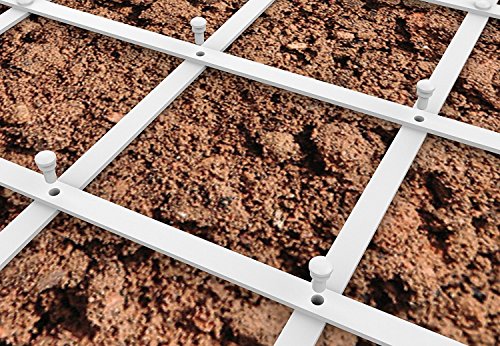
Mr. Garden Grid Kit
Or, you can build your own with wooden lath, though I have also seen gardeners and farmers use a temporary string-and-post setup to cast their measurements instead of wood.
Growing on the Grid
It's these grids that create the magic of the whole concept, and which in turn help to make the whole endeavor of gardening this way so easy.
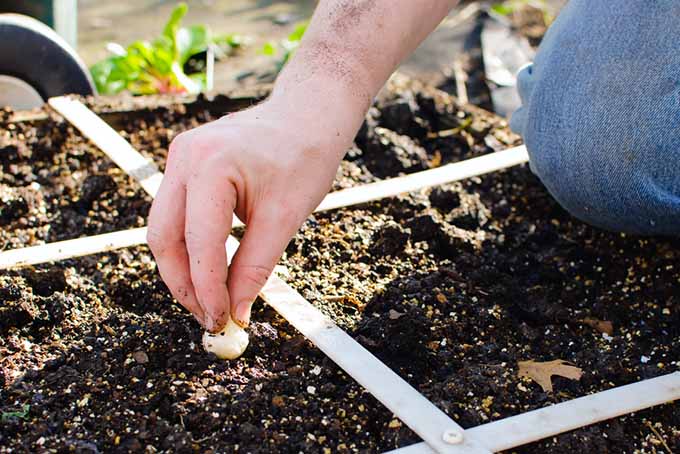
It's simple: certain vegetables are planted in certain amounts (the number depending on the plant) within each square, at their ideal distances from one another. This then maximizes each plant's space and nutrient use while crowding out weeds as a living mulch, allowing you to grow more veggies in a small space, and even boosting plant health through companion planting (which we'll get to later).
Depending on the type of vegetable, herb, or even fruit that you are planting, one only plants so many seeds or seedlings within each square in a continuous grid-like spacing – while the actual grid itself helps to measure and keeps your rows looking neat!
Simply put, all you really have to do is consider the number of plants you need per square, plant them, and make sure to space them at healthy distances in a grid formation within the larger grid.
It's wonderfully easy – no doubt one of the reasons why it's a technique that's caught on like wildfire!
Below, we share the general number and spacing rules for the most common vegetables you might like to plant in your square foot garden.
1-Per-Square Plantings
Simply form one hole in the center of the 1-by-1-foot square of your choice, and plant your seeds (or transplant your seedling), keeping in mind the seeding techniques and layout guidelines that you'll find later in this article.
- Celery
- Corn
- Eggplant
- Kale
- Lettuce (head)
- Okra
- Oregano
- Parsley
- Peppers
- Potatoes
- Rosemary
- Sweet potatoes
- Tomatoes (staked)
2-Per-Square Plantings
Plant these seeds side by side within the square, at the recommended seeding distance with an appropriate support trellis.
- Cantaloupe
- Cucumbers
- Pumpkins
- Watermelons
- Winter squash

(Up to) 4-Per-Square Plantings
Plant these in a square with each seed or plant forming one of the four corners. They should be placed at equal distances from each other and from the border of the grid, with one hole close to each corner of the square space.
As noted, some of these veggies do not necessarily have to be planted 4 per square. If you want to grow a little less food, you may do so.
- Basil
- Garlic (for growing larger bulbs)
- Kohlrabi
- Leeks (for growing larger plants)
- Lettuce (leaf)
- Onions (for growing larger bulbs)
- Winter radishes
- Rutabaga
- Summer squash (with cage)
- Swiss chard
- Tomatoes (with cage)
- Zucchini (with cage)
(Up to) 8- or 9-Per-Square Plantings
Plant these in a grid- or square-like pattern within the square space (i.e. 3 plants long by 3 plants wide, forming either a square or a square-shaped ring border, simply making sure that they are equidistant from one another and the border of the grid.
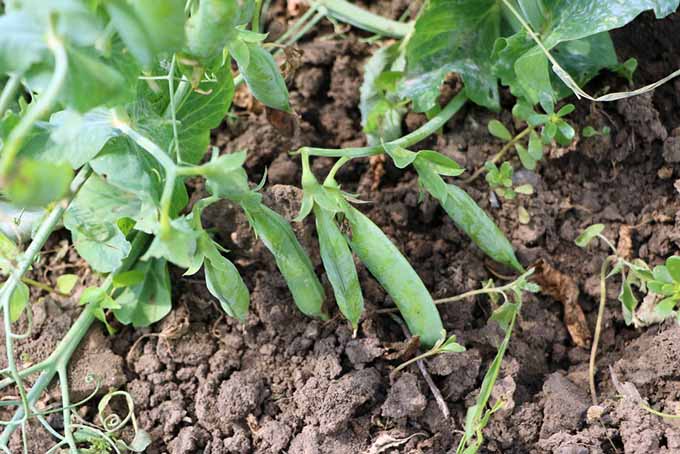
Like with 4-per-square plantings, don't feel pressured to plant that many of each vegetable if you don't necessarily want that much food!
- Green beans (bush or pole)
- Beets
- Cilantro
- Garlic (smaller bulbs harvested, but more plants)
- Leeks (smaller but more plants)
- Onions (smaller but more plants)
- Peas
- Spinach
- Tomatoes (with no supports)
- Turnips
(Up to) 16-Per-Square Plantings
Plant these in a grid or square pattern within each square space (i.e. a maximum of 4 plants long by 4 plants wide). Make sure they are equidistant from each another and the border of the grid to avoid crowding.
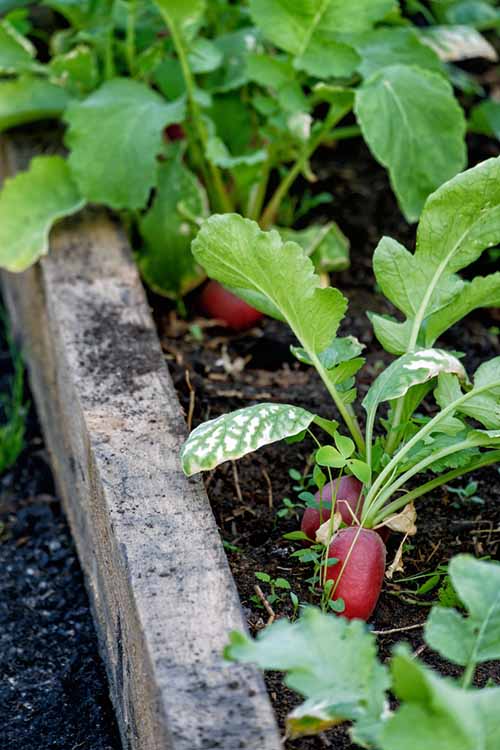
If you don't plan to thin or pick any of these vegetables for quite awhile, plant less if you like – you might prefer to use the 8- or 9-per-square spacing method. This will allow their root size to grow larger without leading to bolting or disease.
- Carrots
- Parsnips
- Radishes
(Up to) 2-Per-4 Planting Squares
The veggies in this category need LOTS of space to flourish, and a more complex arrangement of the square grid method is required than for other crops.
Depending on the number you wish to plant, just make sure they have ample space from one another and the sides of the grid.
- Broccoli
- Brussels sprouts
- Cabbage
- Cauliflower

What About Perennial Vegetables?
Unfortunately, some vegetables simply aren't ideal for the square foot garden, namely perennials that require more space to grow. The foliage of these plants grows too large and creates too much overshadowing to grow in a companion planting style close to other veggies in a garden.
These include:
- Artichokes
- Asparagus
- Rhubarb
The ferns of full-grown asparagus would fall over onto other plants, as would the growth of artichokes and rhubarb. You'll have to keep these separate!
Another unique aspect of this gardening technique is found in the way you plan your growing space – or more specifically, where every plant and veggie is going to go within that space, in order to get the maximum benefits out of your small garden.
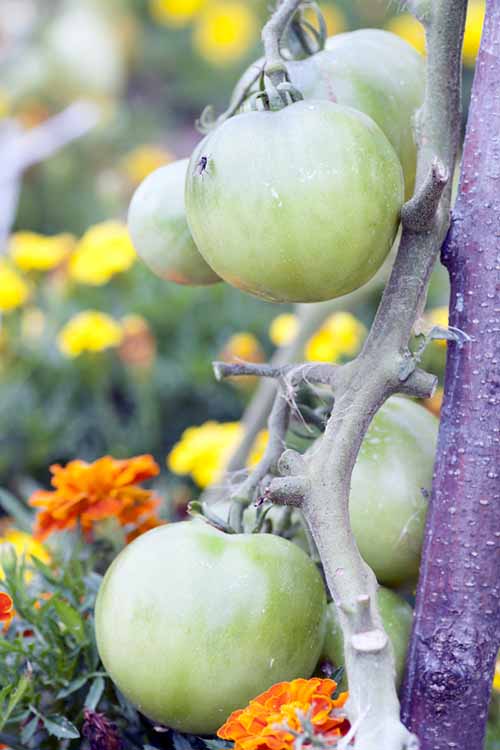
Techniques like companion planting are a big part of this, too – namely, the mutually beneficial inter-planting of different species with one another for natural perks like insect resistance and disease prevention.
Within your 4-by-4-foot space, carefully selecting the type of plants that you plant together – and even where you plant them within your container, and within each space of the grid – is very important.
You can use the following tips in combination with the grid setup guidelines described above to plan which squares will be best for which plants, especially if you're planting many different things.
Making a mock-up and getting all of your arrangement ideas down on paper is a great idea for this part of the planning process!
Below is a list of the best companion planting layout tips for your square foot garden – so you can produce the most productive, happy, disease-free, and harmonious harvest possible!
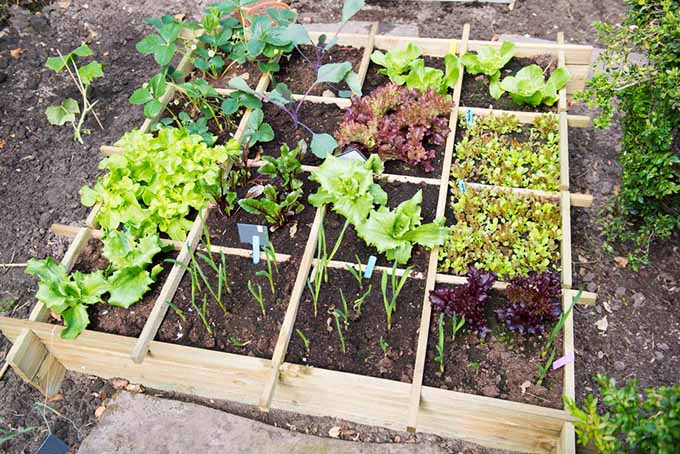
The exact placement of these companion plantings in your square foot garden is important.
Companion Planting Tips
Not all plants get along. Some compete with one another for nutrients, or attract harmful pests that can be detrimental to certain plant neighbors.
On the other hand, some special pairings do exactly the opposite: they bring out the very best in each other, attract the right insects or pollinators, and create the perfect healthy balance.
Before planting your seeds (or transplanting your seedlings) into your raised bed, do the necessary research to determine what you should plant together within each square.
Stay tuned for a deep dive into companion planting in the very near future.
Adopt and adhere to these very straightforward guidelines for the best results – especially if you're companion planting in your bed (and you should be)!
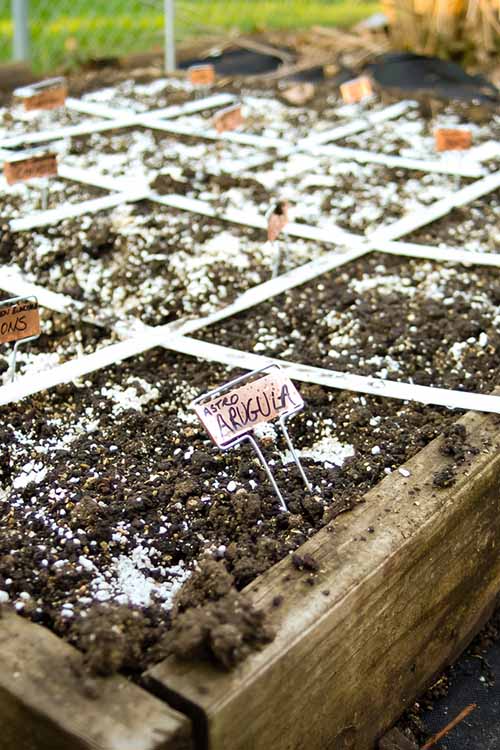
No Monoculture
Always plant your square foot garden with a variety of mutually benefitting plants, since one variety planted closely together will attract more pests and disease.
Keep Height in Mind
If planting short sun- and heat-loving plants with taller ones, make sure to plant taller veggies (e.g. tomatoes, peppers, and eggplants) on the north side of your bed to allow shorter ones (like basil, bush beans, celery) to get their share of the sun's rays.
On the other hand: If mixing tall plants with a blend of shade- and heat-loving plants, plant your tall ones right in the middle. Plant shade-lovers on the north side of them, and heat-lovers on the south side.
Border with Veggie Protectors!
Border your growing space with alliums (i.e. onions, garlic, leeks, shallots) since these repel insects and pests (but keep them far from beans).

Add a Flourish of Color (and Pest Control)
Planting certain herbs and flowers – such as sage with brassicas, or marigolds with nightshades – helps to repel certain insects like egg-laying butterflies and nematodes.
Starting Out
So you've decided which veggies you want to grow in your little garden – and now you know exactly how many to put into each square.
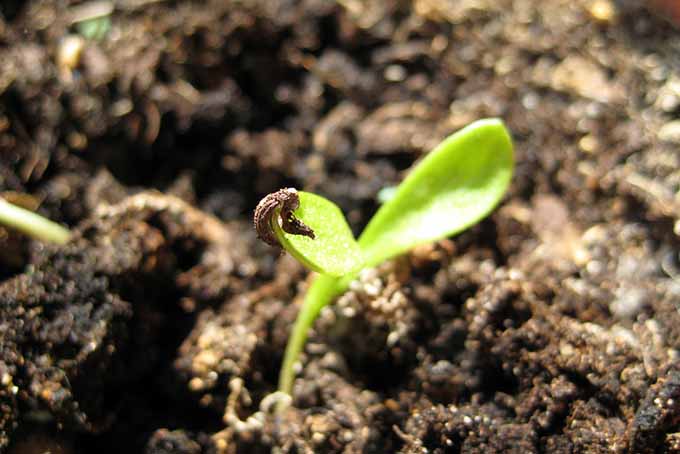
Here's the next step: getting them started from seed!
In the same vein as planting using a grid, square foot gardening employs its own unique approach to seed starting. This involves thinning out weak seedlings so you only give nourishment to the strongest, most (potentially) successful ones for the most productive garden.
When planting seeds:
1. Form Holes for Each Seed
First, form holes in each square using your finger or another tool, correlating to the number of plants you will be growing (which depends on the type – reference the list provided above).
Make sure holes are set up in an equidistant, grid-like fashion within each square, so that plants are equally spaced apart in their correct number – this arrangement will differ depending on the total number (either 1, 2, 4, 9, or 16).
2. Place and Plant Your Seeds
Plant 2 to 3 seeds of your chosen vegetable in each hole. Cover lightly with soil, then water.
3. Watch Them Grow
Once sprouted, choose the strongest-looking seedling from each set of 2-3 seeds that you have planted and remove the others to give it clearance. This will become your final, full-grown vegetable or herb!
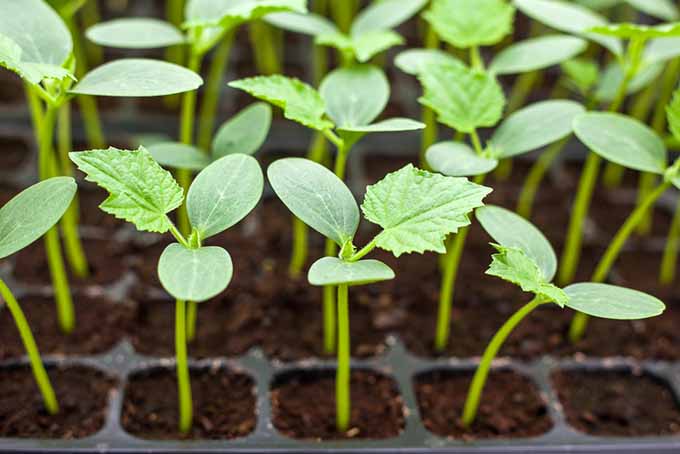
Some may choose to direct seed straight into their bed, as the instructions above demonstrate. However, lovers of the seed-starting and transplanting tradition don't have to change their ways to make this gardening method work.
Planting appropriate veggies (i.e. those that do well with transplanting) in smaller containers first, then sizing them up before transplanting into their final space, works just as well if you enjoy that method – and especially if you want to get started earlier on your garden indoors during cold seasons!
Setting the Pace
Once your seedlings and sprouts are well on their way in your square foot garden – well, you know the rest!
Water regularly, harvest, and enjoy. You'll be amazed by how much food you can cultivate in such a small space, and with so little work required once your seedlings have sprouted. And once you've harvested everything you can eat, it's shockingly simple to plant another succession and have delicious veggies again in no time.
If some seedlings don't do so well, just plant new seeds in their place. However, it's wise in more crowded squares (such as in 8-, 9-, and 16-plant spacings) to wait for other successful veggies in the same plot to reach maturity and harvest first, so they don't overshadow and crowd out your tiny new plant introductions.
Not only will you have a flourishing, quaint food garden with minimal effort in comparison to what it takes to manage a full-sized one, you'll also see significant savings in terms of your food budget.
Who doesn't want fresh, homegrown produce straight from their own yard (and the fruit of their own labors) and from their very own hands? Nothing beats veggies you grow yourself.
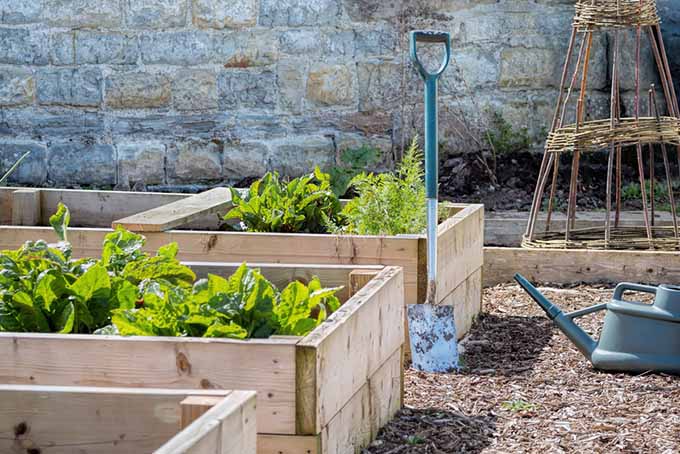
You can also practice this method with practically no change, potential negative consequences, or damage to your space. There's no need to dig up your garden soil – you can set up your square foot garden on your patio, balcony, or lawn without breaking any soil (or even a sweat)!
Of course, keep in mind that not all raised beds may be appropriate for all surfaces. With any bed you build or buy, look into the details on where the best setup should take place without creating drainage problems, rot, or damage to the surface blow, depending on your product or design.
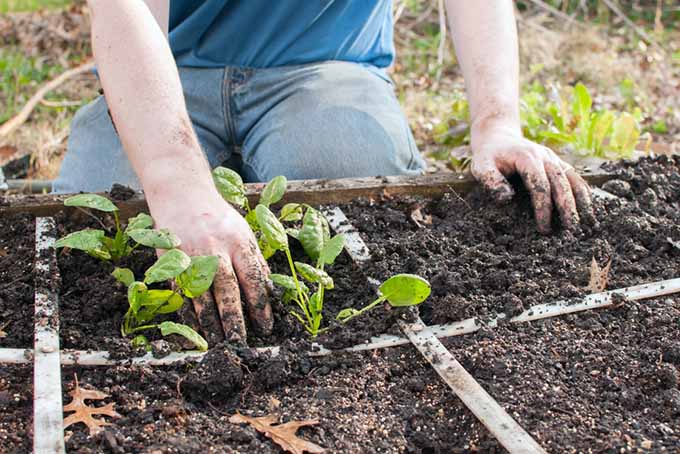
About Adrian White
Adrian White is a certified herbalist, organic farmer, and health/food writer and expert. She aims to bridge the world of natural, holistic health and nutrition to the realm of organic foods, herbalism, gardening, and sustainability - or "Food as Medicine" - throughout her writing.
Square Foot Gardening Layout Plans Free
Source: https://gardenerspath.com/how-to/design/guide-to-square-foot-gardening/
Posted by: brownleehatterouble.blogspot.com

0 Response to "Square Foot Gardening Layout Plans Free"
Post a Comment